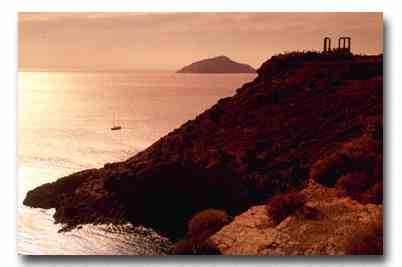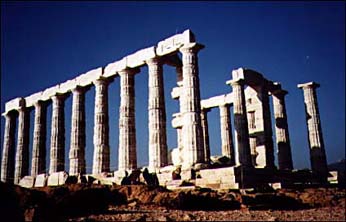
Discovering Patterns in Evidence: Repetition, Arrangement, Juxtaposition, Orientation, Relationship to Similar Objects, etc.

The temple of Poseidon at Cape Sunion, at the end of the peninsula overlooking the Aegean Sea toward Persia.

This temple's construction and location, like any work of literature, is an enormous set of data for the scholar. What patterns do you see in its construction as evidence for what kinds of shapes and concepts the ancient Greeks thought a structure should have if it was intended to be pleasing to the gods? The repetition of columns establishes a cumulative architectural mass that affects the viewer's eye much differently than would a similarly tall and wide wall of solid stone. Their orientation to each other in geometrically precise parallels and perpendicular orientations to the "lintels" or top stones establishes lines of sight and creates coherence in the design, structurally and aesthetically. What sense could you make of the entire temple's location? Its juxtaposition with the sea on the southernmost tip of the Greek landmass certainly seems appropriate to honoring Poseidon, the god of the sea and earthquakes. Consider that, before this temple was built to honor the god of the sea, the Persian Empire had invaded Greece twice in ten years, the second time destroying all of the temples in Athens. The second time, the land army was far more successful than the first because of its strategic support by the Persian navy. Consider further that this is one of a series of temples built above and below Athens on the pathways by which an invading enemy would have to approach. What does this tell us about Greek religious faith, their expectations of their gods' power, and their beliefs in what might motivate the gods? Consider still further that this architectural style was copied by the designers of Washington, D.C.'s early large monuments and official buildings. What does that say about our monuments' relationship to Greek values, and how might that affect claims that this country was founded by people who believed only in Christian values?
The temple stands on the edge of the precipice over which many of its columns have been toppled by centuries of vandals and earthquakes. George Gordon, Lord Byron, carved his name into one of the fallen columns within the temple, itself. That's another kind of evidence, of course, but one that has meaning for Byron scholars.